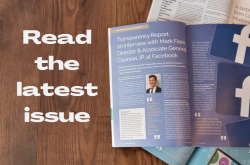The Federal Circuit’s decision in In re Erik Brunetti represents a pivotal moment in trademark law’s evolving “failure to function” doctrine. While vacating the Trademark Trial and Appeal Board’s (the Board) refusal to register FUCK as a trademark, the court’s primary concern wasn’t the propriety of registering profanity—that issue was settled in the Supreme Court’s 2019 Iancu v. Brunetti decision. Instead, the Federal Circuit took aim at the USPTO’s increasingly opaque standards for determining when commonplace words can serve as source identifiers.
The Board’s reasoning and its fatal flaw
The Board had affirmed the examining attorney’s refusal on the grounds that “FUCK” is an “all-purpose word” conveying such a wide range of meanings and emotions that consumers wouldn’t perceive it as indicating source. The Board emphasized the term’s ubiquity across various goods, including those in Brunetti’s applications (sunglasses, jewelry, bags, and retail services).
Critically, however, the Board failed to articulate a coherent standard distinguishing registrable from non-registrable “all-purpose words.” As Judge Dyk noted, the Board dismissed Brunetti’s citations to registered marks like “LOVE” and even third-party registrations of “FUCK” itself for snow globes and gummy candies, stating these were “not relevant…perceived in a vacuum without any contextual information.” Yet the Board never explained what contextual information would be relevant or what evidence could demonstrate consumer perception of source indication.
The “I know it when I see it” problem
The Federal Circuit’s sharpest criticism targeted what it characterized as the Board’s “I know it when I see it” approach—explicitly invoking Justice Stewart’s famous phrase from Jacobellis v. Ohio. This approach, the court held, violates the Administrative Procedure Act’s (APA) requirement for reasoned decision-making. The court demanded “rational guidance that is sufficiently explained,” particularly given the “increasing number of failure-to-function refusals in recent years.”
This criticism strikes at a fundamental tension in trademark law. While source identification is necessarily a factual inquiry dependent on consumer perception, the USPTO must provide predictable guidance to applicants and examining attorneys. The current framework, where examining attorneys reach contradictory conclusions on nearly identical marks, undermines both administrative efficiency and public confidence in the trademark system.
Implications for practice
For trademark practitioners, this decision offers both opportunities and challenges:
- Challenging refusals: The decision provides powerful ammunition against failure-to-function refusals. Practitioners can now demand that examining attorneys and the Board articulate specific, clear standards rather than relying on vague assertions about “commonplace” usage. The existence of similar registered marks becomes more relevant, as the USPTO must explain apparent inconsistencies rather than dismissing them as irrelevant.
- Application strategy: Consider filing applications with enhanced evidence of source-indicating use. While the Board suggested Brunetti could have provided “competent evidence that consumers would perceive the proposed mark as a source identifier,” it never specified what such evidence would entail. Consumer surveys, evidence of exclusive use in commerce, or distinctive stylization might strengthen applications for commonplace terms.
- Watching for Board guidance: On remand, the Board must articulate clearer standards. This precedential decision will likely establish the framework for evaluating all-purpose word marks going forward. Practitioners should monitor this closely, as it may fundamentally reshape prosecution strategies for word marks.
Broader doctrinal questions
Judge Lourie’s dissent raises an uncomfortable truth: some words may be so inherently expressive and variable in meaning that they genuinely cannot function as trademarks for broad categories of goods. His observation that “anyone living in today’s society of degraded language can readily tell” the answer highlights the challenge of reducing sociological and linguistic realities to administrable legal standards.
The majority’s response—demanding clarity even in difficult cases—reflects a broader administrative law principle. Agencies cannot escape APA requirements simply because line-drawing is challenging. The USPTO must develop articulable standards even for inherently fuzzy concepts like consumer perception.
Looking forward
This decision will likely catalyze significant developments in failure-to-function doctrine. The USPTO may need to develop more sophisticated frameworks for evaluating commonplace terms, potentially incorporating empirical evidence of consumer perception, marketplace analysis, or linguistic expertise. The Board might distinguish between different types of commonplace words—those with stable meanings versus “all-purpose words” with variable meanings.
For now, practitioners should prepare for a period of uncertainty followed by potentially significant doctrinal evolution. The Federal Circuit has demanded clarity, but achieving it will require the USPTO to grapple with fundamental questions about the nature of source identification in an era of increasingly casual and varied linguistic usage.

Written by Ed Lanquist
Shareholder, Registered Patent Attorney, Mediator, Baker Donelson
You may also like…
UEFA partners with Alliance for Creativity and Entertainment to enhance global anti-piracy strategy
October 21, 2025 - The Union of European Football Associations (UEFA) has officially joined the Alliance for...
EUIPO and UANIPIO welcome the integration of Ukraine’s trademarks into TMview
The European Union Intellectual Property Office (EUIPO) and the Ukrainian National Office for Intellectual Property...
Jägermeister succeeds in opposing the EU trademark application Alten Kräuterfrau for alcoholic beverages
Mast-Jägermeister SE filed an opposition on the grounds of Article 8(1)(b) – likelihood of confusion between the signs...
Contact us to write for out Newsletter














